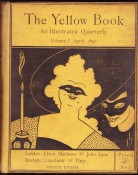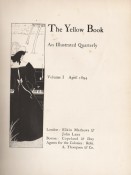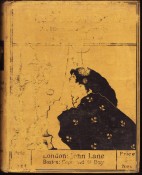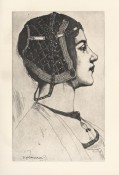Volumes I - XIII (the complete set), original yellow decorated cloth, illustrated throughout, edges uncut, with the library ticket of B. Fairfax Hall at the top of each front free endpaper. The cloth is soiled, the upper cover of volume III appears to have been affected by damp which has removed most of the titling, several of the volumes are partly unopened, foxing on the endpapers but overall the contents are crisp and clean.
‘The Yellow Book, published in London from 1894 to 1897 by Elkin Mathews and John Lane, later by John Lane alone, and edited by the American Henry Harland,[1] was a quarterly literary periodical (priced at 5s.) that lent its name to the "Yellow Nineties".
‘It was a leading journal of the British 1890s; to some degree associated with Aestheticism and Decadence, the magazine contained a wide range of literary and artistic genres, poetry, short stories, essays, book illustrations, portraits, and reproductions of paintings. Aubrey Beardsley was its first art editor,[2] and he has been credited with the idea of the yellow cover, with its association with illicit French fiction of the period. He obtained works by such artists as Charles Conder, William Rothenstein, John Singer Sargent, Walter Sickert, and Philip Wilson Steer. The literary content was no less distinguished; authors who contributed were: Max Beerbohm, Arnold Bennett, "Baron Corvo", Ernest Dowson, George Gissing, Sir Edmund Gosse, Henry James, Richard Le Gallienne, Charlotte Mew, Arthur Symons, H. G. Wells, William Butler Yeats.
‘Though Oscar Wilde never published anything within its pages, it was linked to him because Beardsley had illustrated his Salomé and because he was on friendly terms with many of the contributors. Soon after Wilde was arrested in April 1895 Beardsley was dismissed as the periodical's art editor; his post taken over by the publisher, John Lane, assisted by another artist, Patten Wilson. Although critics have contended that the quality of its contents declined after Beardsley left and that The Yellow Book became a vehicle for promoting the work of Lane's authors, a remarkably high standard in both art and literature was maintained until the periodical ceased publication in the spring of 1897.’ (Wikipedia)
‘B. Fairfax Hall was a private printing enthusiast. In England in 1930 he founded and operated The Stourton Press, named after the family’s house in Westminster. Hall was a member of P.D. Ouspensky’s circle before he emigrated to South Africa. In 1947 he began to print books, including Ouspensky’s “A Record of Meetings,” in an edition of twenty copies in 1951, and “The Struggle of the Magicians,” in an edition of ten copies in 1957.’ (https://gurdjieffbooks.wordpress.com/tag/the-stourton-press/).
Among his publications whilst in Cape Town was Rupert Shephard's Passing Scene: Eighteen Images of South Africa (1966). He returned to England after disposing of much of his library through a local dealer.
- Size: 8vo (205 x 165 mm)
- Sold By: Clarke's Africana & Rare Books
- Contact Person: Paul Mills
- Country: South Africa
- Email: [email protected]
- Telephone: 021 794 0600
- Preferred Payment Methods: Visa & Mastercard via PayGate secure links and Bank transfers.
- Trade Associations: ABA - ILAB, SABDA






















